Slatina Sparkling Wine Find Makes Slavonia Champagne Among Croatia's Oldest
February 13, 2021 – A newly discovered, fully preserved bottle of 'Slavonia champagne' is unique evidence that Slatina sparkling wine is among the oldest in Croatia. Its fascinating history stretches back over 150 years
A completely preserved Slatina sparkling wine bottle from the period from 1864 to 1912 has been discovered during building works of Slatina's new visitor's centre. Found at a depth of two metres, the bottle is physical proof of what was previously known only from records – this 'Slavonia champagne' is among the oldest sparkling wine to have been made in Croatia.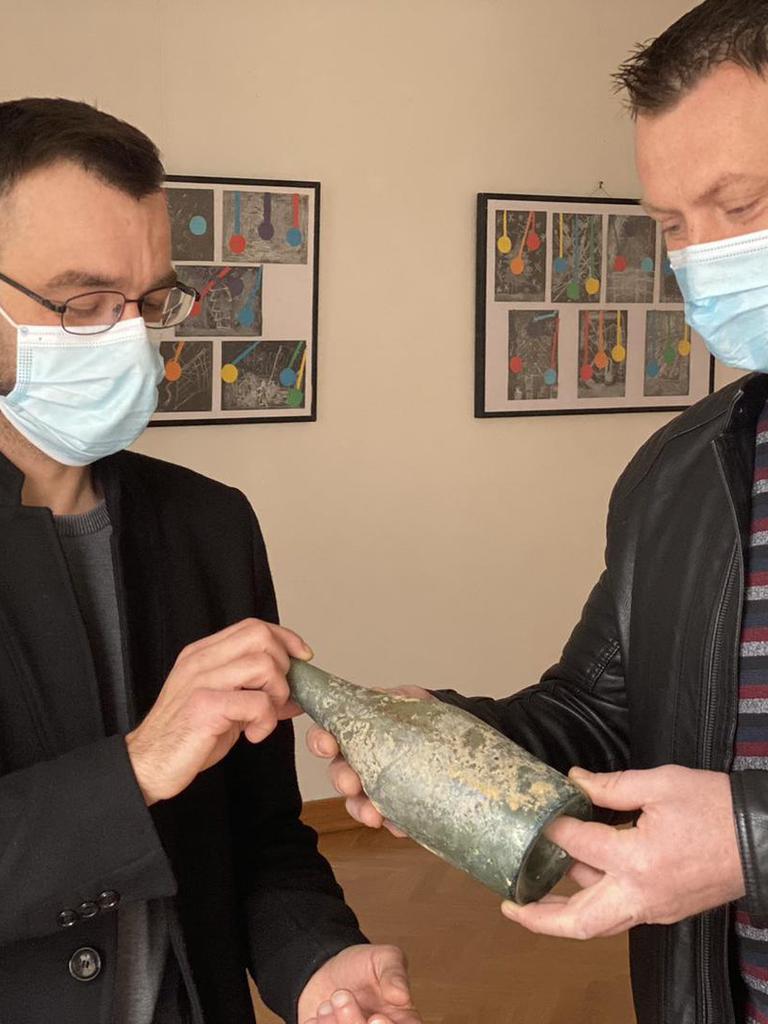 © Robert Turkalj
© Robert Turkalj
The discovery of the Slatina sparkling wine bottle is important to the city and its history. Other regions in Croatia have become extremely well regarded over recent years for their production of quality sparkling wines. The production of Slatina sparkling wine briefly disappeared during a period. But, this bottle is evidence that Slatina sparkling wine was among the first to be made in the country. It is the only fully preserved bottle of the 'Slavonia champagne' to exist in the region.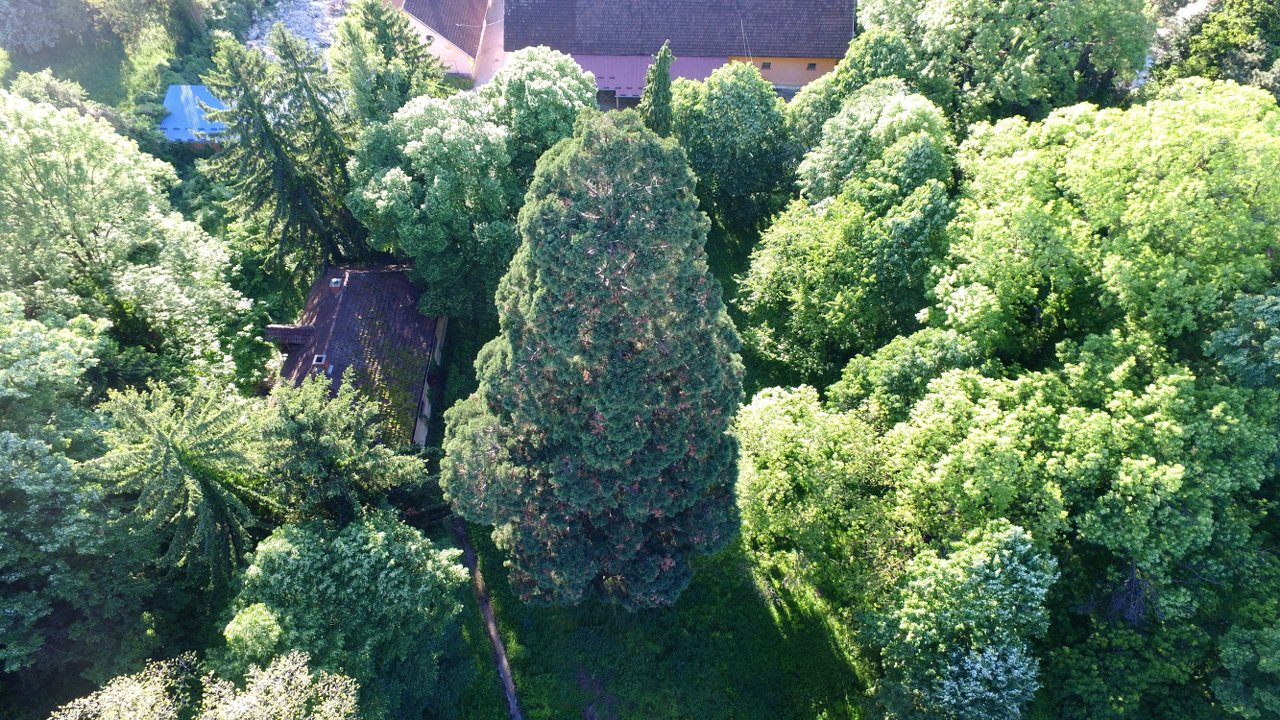 Slatina's nationally protected Giant Sequoia tree (Mamutovac) © Tourist Board of Slatina
Slatina's nationally protected Giant Sequoia tree (Mamutovac) © Tourist Board of Slatina
Of course, we can't really call it champagne – that title is reserved for a type of sparkling wine made in a distinct geographical region in France. But, there are great similarities between Slatina sparkling wine and champagne - similarities that do not exist exactly in other Croatian sparkling wines. Champagne is largely made from the Pinot Noir grape. The found bottle of Slatina sparkling wine was made from the Kadarka grape variety, which has been compared to Pinot Noir.
Both grape varieties are thin-skinned, delicate, easily susceptible to impairment and require a low yield to produce quality wines. Both are tricky to cultivate. For this reason, the Kadarka grape variety is now grown very rarely in Croatia, its place in vineyards taken by more hardy and some imported varietals. But, that wasn't always the case.
History of Slatina sparkling wine
In 1841, the German prince Georg Wilhelm Schaumburg-Lippe bought a property of land in the Slatina area from the Pejačević family. The land contained vineyards, orchards, agricultural fields and large forest areas, including the site of the new Slatina visitor centre where the bottle was discovered. Indeed, trees still line the road of Ulica kralj Zvonimir in the centre of Slatina – the cellar and restaurant of the town's famous Stari Podrum is just a few metres from Slatina's nationally protected Giant Sequoia tree (Mamutovac).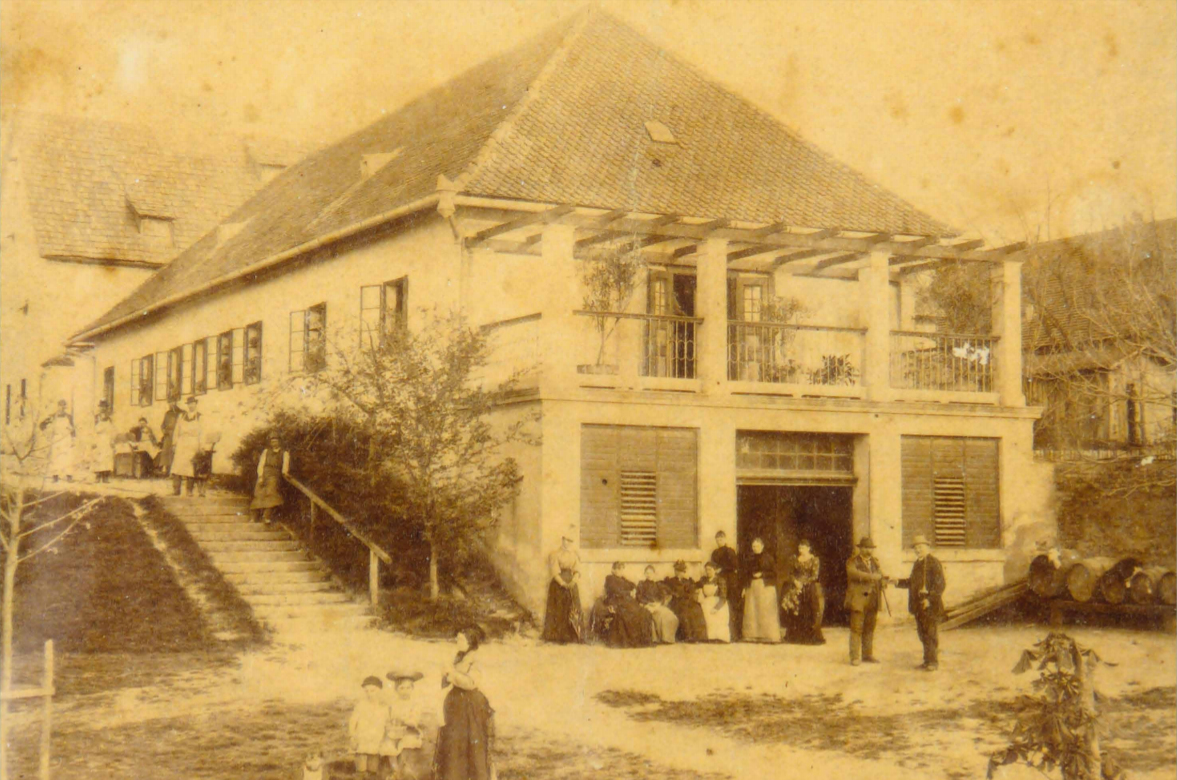 The Stari Podrum cellar, the site of the first-ever production of Croatian sparkling wine, at the beginning of the 20th century © Virovitica State Archives / Slatina Homeland Museum
The Stari Podrum cellar, the site of the first-ever production of Croatian sparkling wine, at the beginning of the 20th century © Virovitica State Archives / Slatina Homeland Museum
Slatina sparkling wine production started in 1864 at the Stari Podrum cellar, using the Kadarka grape variety. Perhaps it was the notorious difficulties of the growing the grape which resulted in slow initial progress for the production, but the enterprise got a massive boost in 1866 with the arrival of a new manager, Otto Rockhror. He rearranged the cellar and production, brought in new equipment and invested in marketing their Slatina sparkling wine. It worked.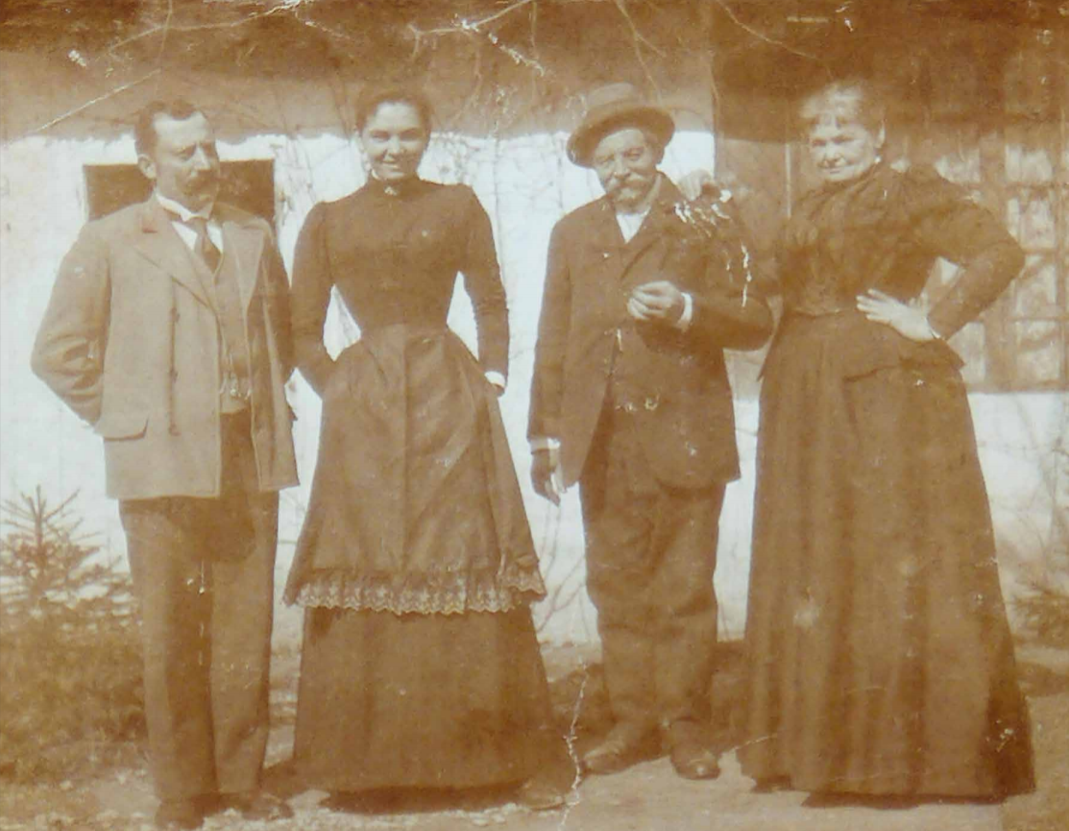 Left to right - Ljudevit Konstantinović, his wife Marija Konstantinović (the daughter of Otto Rockrohr), Otto Rockrohr and his wife Josefina Rockrohr © Virovitica State Archives / Slatina Homeland Museum
Left to right - Ljudevit Konstantinović, his wife Marija Konstantinović (the daughter of Otto Rockrohr), Otto Rockrohr and his wife Josefina Rockrohr © Virovitica State Archives / Slatina Homeland Museum
The quality of Slatina sparkling wine was recognized at the great Economic and Forestry Jubilee Exhibition in Zagreb in 1881 when Georg Wilhelm Schaumburg-Lippe received an honorary diploma and a large medal for domestic sparkling wine and fine wine. The credit perhaps lay elsewhere, considering it was the efforts of Otto Rockhror that were no doubt the cause, but, such were the times. However, Otto Rockhror's achievements with Slatina sparkling wine certainly did not go unnoticed.
At the Science and Industry Fair in Brussels, Belgium, in 1888, Otto Rockhror was awarded a bronze medal featuring the image of Leopold I. He received a further bronze medal with the image of Francis Joseph I in 1890 at the Agricultural and Forestry Exhibition in Vienna and was awarded a silver medal with the image of Franz Ferdinand in 1894 in Vienna by the Association for the Promotion of Agricultural Knowledge. These medals are on display in the Slatina Homeland Museum, donated by Otto Rockhror's great-granddaughter Jasna Nosso. They sit alongside a wooden barrel used in the production of Slatina sparkling wine from 1885 and, now, the latest testament to the history of Croatia's oldest sparkling wine production, the newly discovered bottle, which has been transferred to the museum for preservation, safekeeping and dating.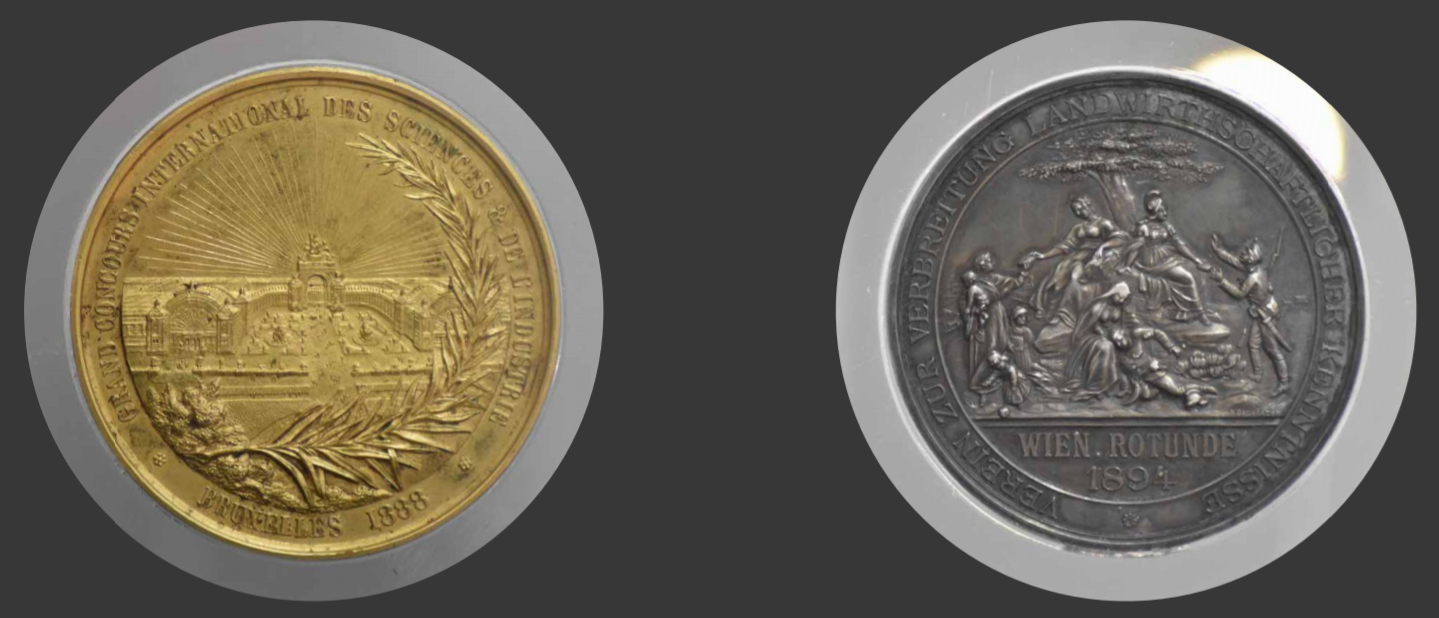 On the left, the bronze medal won by Otto Rockhror at the Science and Industry Fair in Brussels, Belgium, in 1888. On the right, the silver medal with the image of Franz Ferdinand he was awarded in 1894 in Vienna © Virovitica State Archives / Slatina Homeland Museum
On the left, the bronze medal won by Otto Rockhror at the Science and Industry Fair in Brussels, Belgium, in 1888. On the right, the silver medal with the image of Franz Ferdinand he was awarded in 1894 in Vienna © Virovitica State Archives / Slatina Homeland Museum
The production of Slatina sparkling wine from the Kadarka grape did not survive the loss of Stari Podrum cellar manager Otto Rockhror, who died in 1909. Thereafter, ownership of the enterprise was taken over by Count Drašković but, by 1912, production of Slatina sparkling wine had ceased completely and all the production equipment was moved to Hungary. Though the growing of the Kadarka grape variety almost completely died out in Croatia after this, it remains an important part of wine production in Hungary, Bulgaria, Romania and Serbia, where it is grown in Vojvodina, a landscape near-identical to that of Slavonia (indeed, though the heritage of the Kadarka grape is mysterious, the latest opinion is that it is a cross between the Turkish variety Papazkarasi and the Serbian variety Skadarsko and travelled to Pannonia with Serbs who fled north from the Ottomans).
However, the story of Slatina sparkling wine has not only been revived with the discovery of this old bottle. The Stari Podrum cellar still stands in the centre of Slatina today and vineyards still surround the town. The cellar and its wine production were bought by winemaker Ivan Halas over recent years and he has returned the production of Slatina sparkling wine to the historic birthplace of 'Slavonia champagne'. He has since received several awards for his efforts.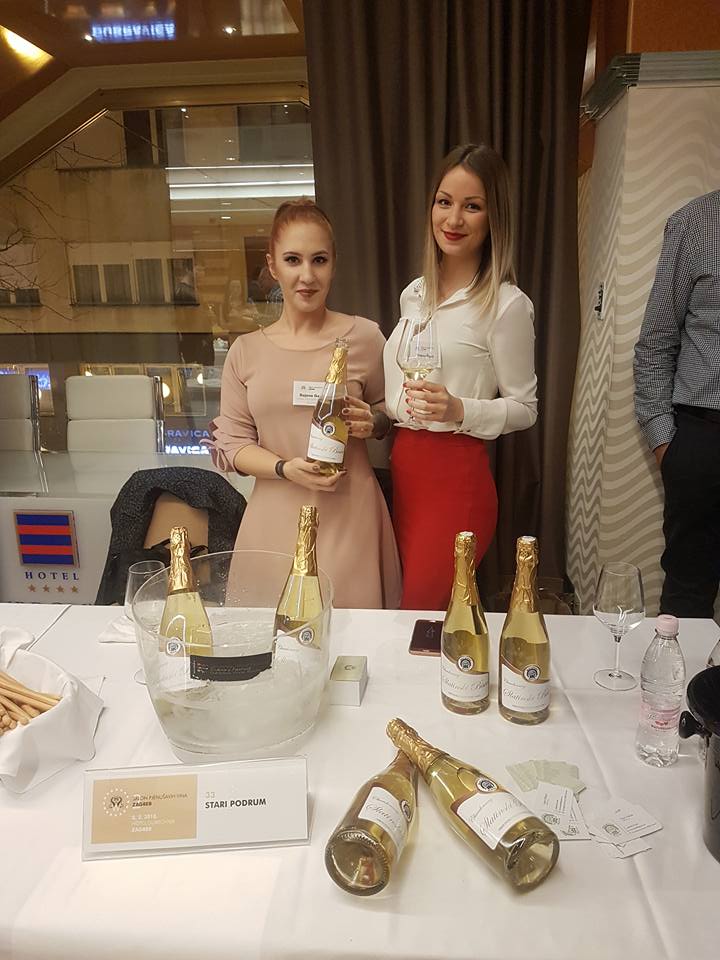 Slatina sparkling wine, revived by Ivan Halas at Stari Podrum, being presented at the 2nd Sparkling Wine Salon at the Hotel Dubrovnik in Zagreb © Tourist Board of Slatina
Slatina sparkling wine, revived by Ivan Halas at Stari Podrum, being presented at the 2nd Sparkling Wine Salon at the Hotel Dubrovnik in Zagreb © Tourist Board of Slatina
“As the Stari Podrum winery does not have adequate conditions for storing the found bottle, we took it to the Homeland Museum in Slatina where it will be stored,” Mr Halas told local news, upon the discovery of the bottle. “Only one bottle was found (so far), although there may be more. It is currently the only fully preserved one in the Slatina area. For now, we assume that it is from the period between 1864 and 1912 - we have no knowledge of the exact year, but the age of the bottle will be determined by experts.”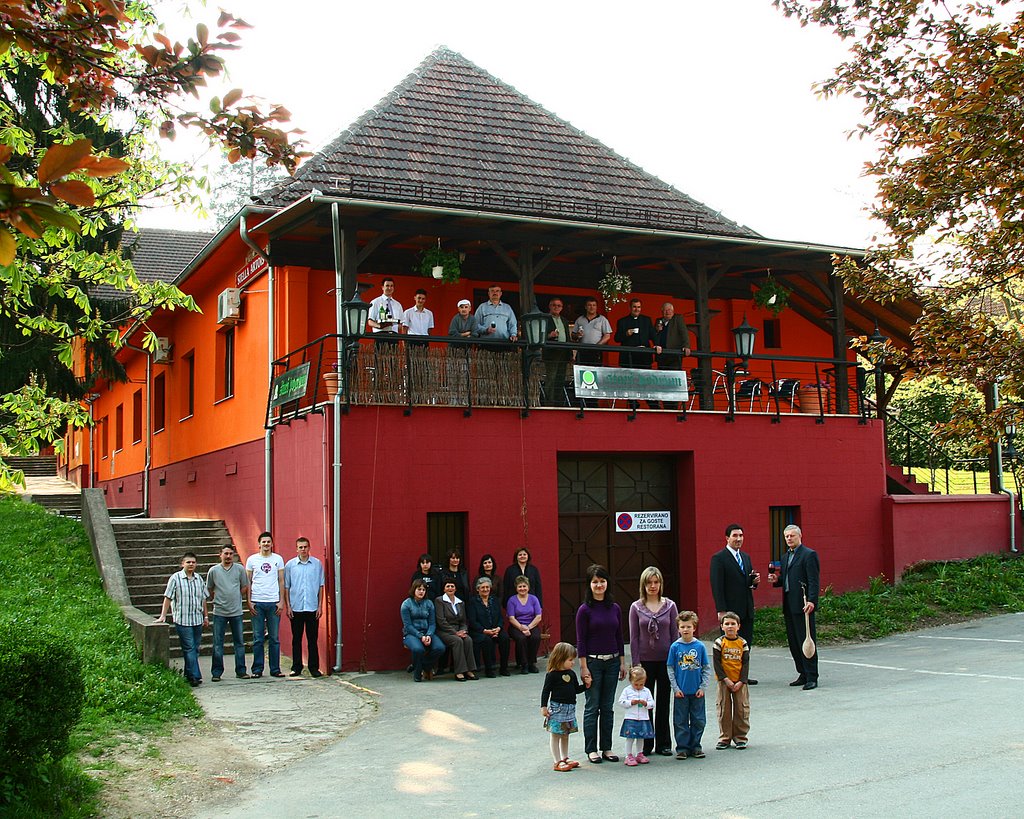 A more contemporary photo of the Stari Podrum enterprise in Slatina © Virovitica State Archives / Slatina Homeland Museum
A more contemporary photo of the Stari Podrum enterprise in Slatina © Virovitica State Archives / Slatina Homeland Museum
Croatia Wine: ”Every Visit Is A Voyage Of Discovery”
August 9, 2020 - Meet Marc Hough, a former international DJ who became a wine importer after visiting Dubrovnik and trying Croatia wine. In 2020, he returns for his 20th summer.
Situated in the north of England, about halfway up the island called Great Britain, the city of Manchester is famous for its football and music. Mancunians are proud of this. Two members of TCN are from the city, and when someone local asks “Odakle si?”, usually we say “Ja sam iz Manchestera” (I am from Manchester). We don't say "I'm from England" or "Great Britain". Everyone knows where Manchester is.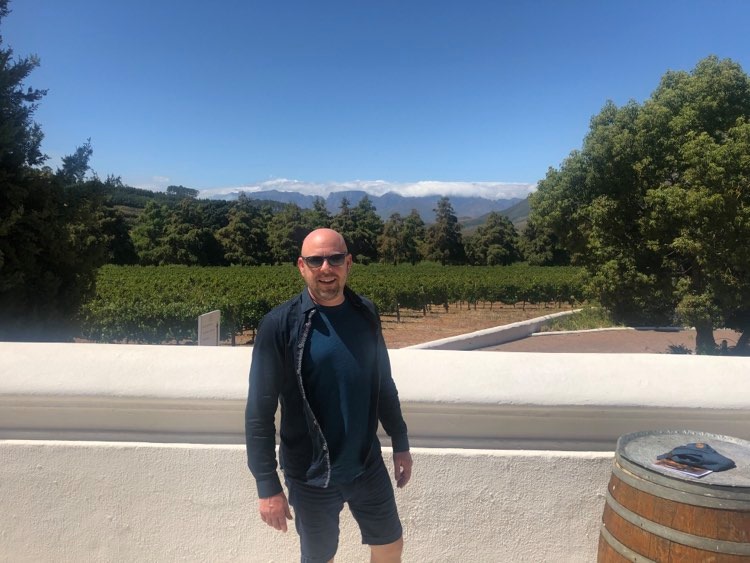
Marc Hough, a former international DJ. His passion for the Plavac he discovered in Dubrovnik turned him into a wine merchant.
20 years ago, Marc Hough was a high profile member of Manchester's famous music scene. He counts members of bands like The Stone Roses and The Happy Mondays as close personal friends. As longstanding DJ to New Order (the band that was once Joy Division), he toured the world playing the music of Manchester to many. But, no more.
“I reached the age of 40 in 2010 and thought, what am I doing with my life?” Hough told TCN over the phone, as he was preparing for a trip Dubrovnik. “DJing and the music business is a young man's game.”
And so, inspired by an enthusiasm for Croatia wine, he turned his back on a high profile DJ career and became a wine bar owner and wine merchant.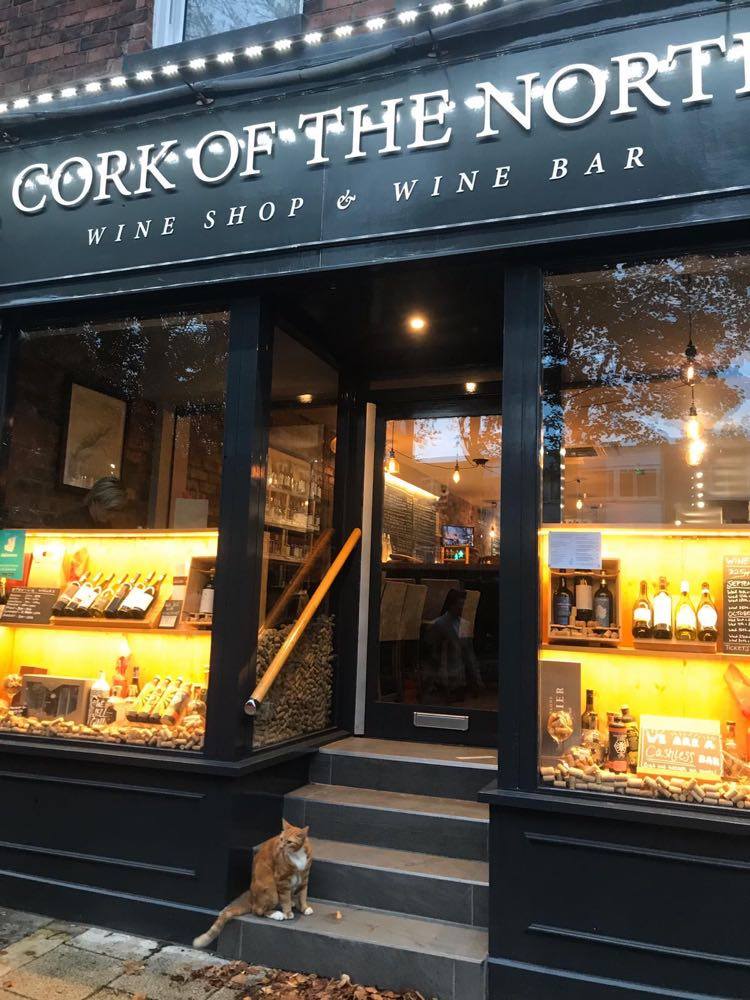
One of Marc's 'Cork Of The North' wine bars / stores near Manchester © Cork Of The North
“When I started, I was literally just selling wine out of the back of my car. I only had five customers and three of those were my dad, my brother and me!” remembers Marc, who has built his independent business considerably since then. He is now a wholesaler, recommending and selling wines to top bars and restaurants in the north of England. He has also opened two of his own wine bars 'Cork Of The North' (which are also wine shops), in Sale and Heaton Moor, near Manchester.
“Croatia plays such a big part in the story,” stresses Marc. “I've been visiting Dubrovnik for over 20 years. I had a friend from there who I met in Manchester. She came to live here for a while to escape the war. After it finished, she went home, invited me to Dubrovnik and I just fell in love with the place.”
“There was a wine bar in the Old Town called D'Vino, run by a half Croatian half Australian guy called Saša. After I saw what he was doing there with Croatia wine, I thought that's exactly the kind of place I'd like to have in Manchester.”
Already passionate about wine thanks to his grandad, that first trip to Dubrovnik made Marc curious to return. On his next visit to Croatia, he travelled further than just the Pearl of the Adriatic and went to the source of some Croatia wine itself.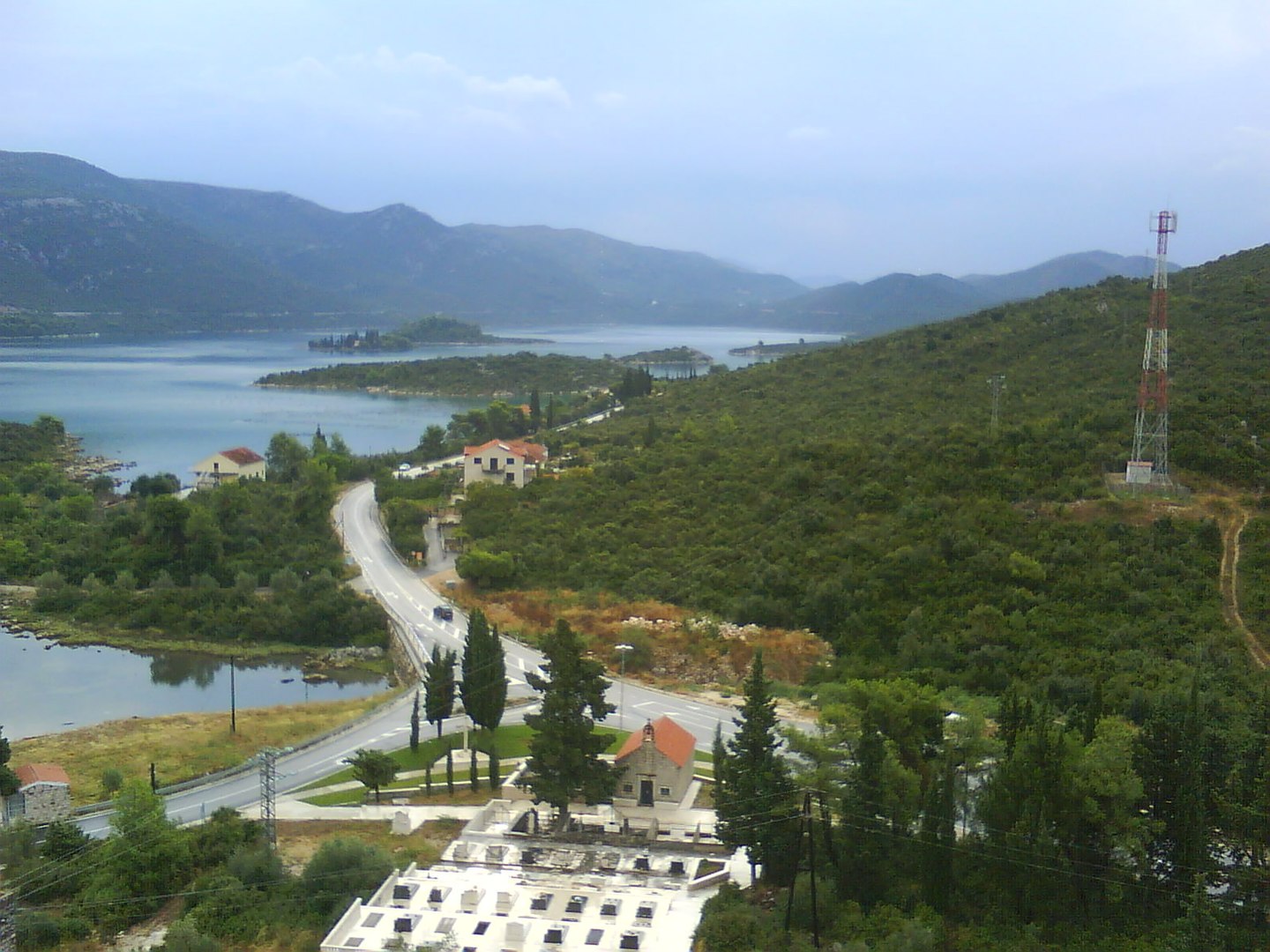
Part of the Pelješac peninsula, which features heavily in Marc's 20-year affair with Croatia wine © Anto
“I came back on a sailing holiday with Bernard Sumner (guitarist of Joy Divison and singer of New Order),” Marc recalls. “He loves sailing and he has his own boat. We went all round Pelješac, Korčula, Brač. I fell in love with Dingač. Since then, I've travelled all of Dalmatia and through Istria learning about the wines. I've been to Bosnia to try their varieties like Vranac. But, for me, the most recent, amazing discovery has been Slavonia. They make some incredible white wines there; Graševina, Cabernet Franc, Traminac.”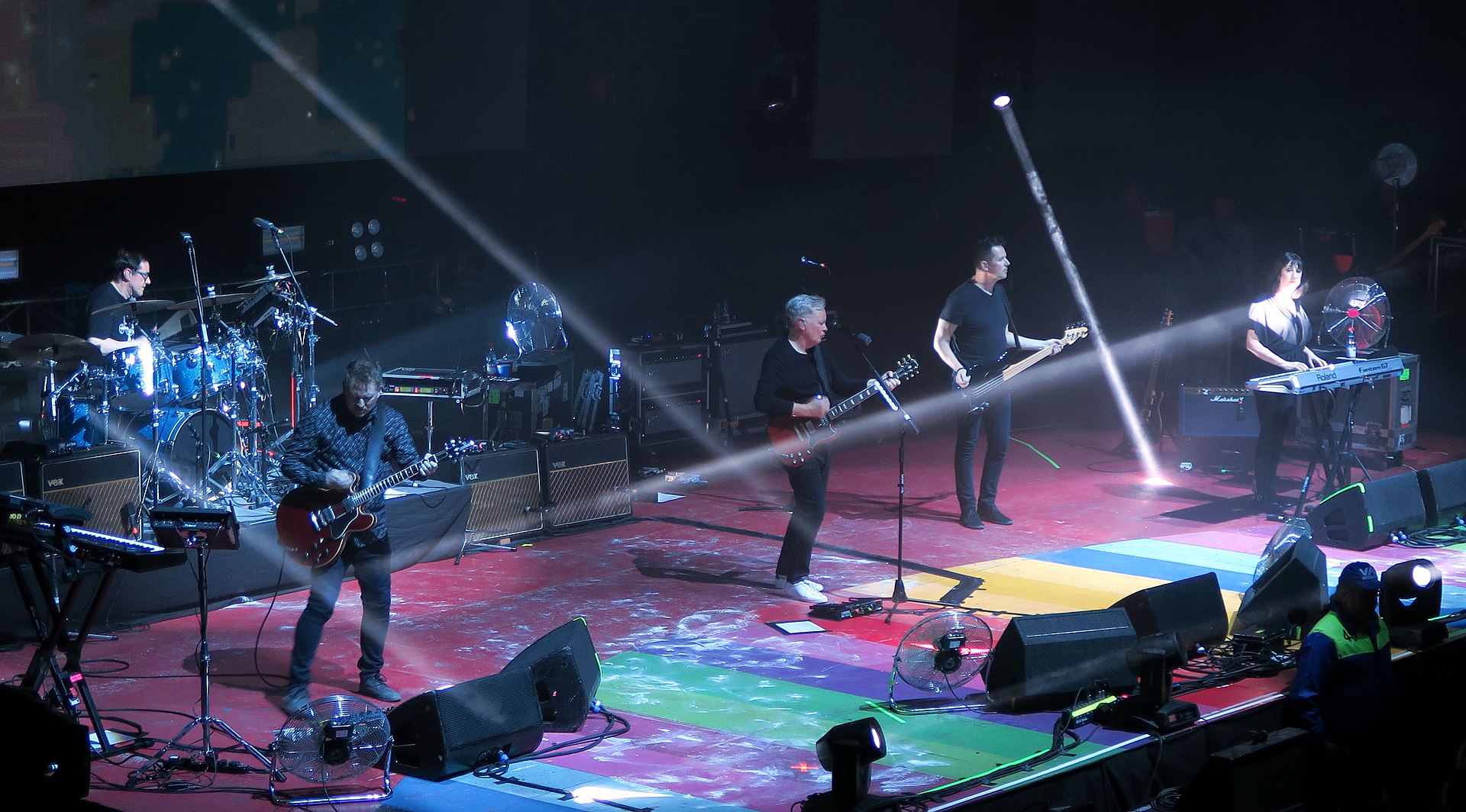
New Order, the band that was once Joy Division. Marc Hough toured the world as their DJ © RL GNZLZ
“For me, it's always half holiday, half work,” Marc tells us, as he packs for his 20th annual trip to Dubrovnik, which begins on Sunday 11 August. “Amazing views, amazing people, amazing food and amazing wine. But, the wine always inspires thoughts of work. I can't help myself. I love visiting the vineyards, meeting the winemakers. It's not the same as when you do it in other countries. In Croatia, you'll often be invited into the kitchen or onto the terrace of the winemaker's home. You'll leave with arms full of different bottles - some gifted - and you can even be sold fine wine unceremoniously in a plastic bottle. I love that informal, homemade feel of the experience. It's charming and honest. When I go on buying trips in France, Spain and Italy, it's rarely like that.”
Dubrovnik's tourist season has this year stalled in response to COVID-19. Its visitors' reliance on charter air and cruise ships has proved inflexible. Yet, a little further up the coast, in Makarska and Omiš, the city centres are now full of families who drive to these places every year. Dubrovnik's offer is more once-in-a-lifetime, less loyalty. Unless, of course, it's the wines and not the walls that call you to Dubrovnik.
“It's inevitable that I'll find something new that I want to bring back with me,” Marc says of his impending trip. “Every visit is a voyage of discovery. This time, although I'll again be based around Dubrovnik, I'm determined to go to Slavonia to look at some Graševina and Cabernet Franc, which thrives in the terroir there.”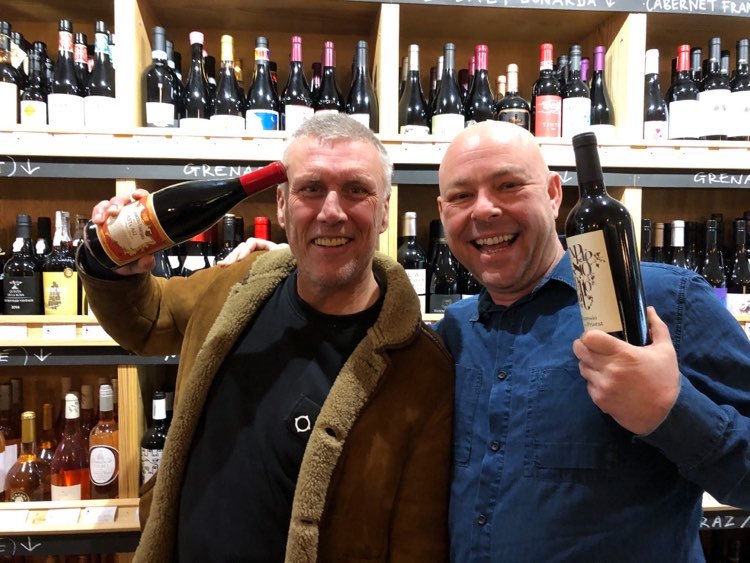
Marc Hough with just one of his famous friends from the Manchester music scene. Bez, of the band Happy Mondays, is now a customer at Cork Of The North © Cork Of The North
“I wanted to start importing Croatia wines years ago but, for someone at my level, it was so difficult before Croatia became a full member of the EU. Tariffs were payable on the borders and if you wanted to move wines from south Dalmatia - Dubrovnik and the islands - you'd have to go through the border with Bosnia. I lost several whole shipments to the Bosnian police, who said my paperwork was incorrect (it wasn't). It's much better these days. But, there's still very little Croatian wine in the UK, even though the interest in Croatia wine is massive. There's a big demand from people who are really passionate about wine, but also people who come back from holiday, have enjoyed Croatian wine, go searching for it, and just can't find it.”
Cork Of The North varies its selection of fine wines throughout the year. At the moment, Marc stocks Kozlović Teran and Kozlović Malvasia from Istria and Septem Pontes Plavac Mali from Pelješac.
“For an independent like me, I buy an export pallet for each wine I want to bring back. That's 600 bottles of each wine.,” he says, “and as my own personal passion right now is for Graševina, I expect at least one of those to be filled with Slavonian wine on this trip.”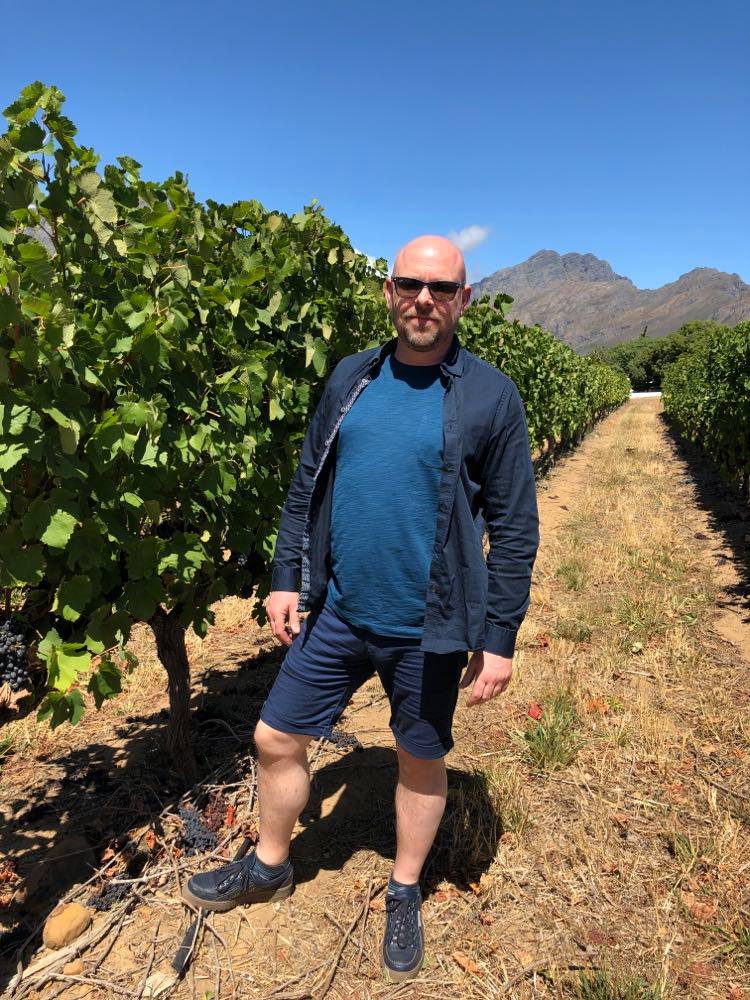
Marc Hough on one of his Croatia wine buying excursions
Slavonian Store Encourages Purchase of Local Produce and More
This Slavonian store is a unique selling point where the shelves feature a rich assortment of local produce from local Slavonian OPGs, handmade souvenirs, and traditional ethno clothing items.
As Poslovni Dnevnik writes on the 26th of April, 2019, in the first year, sales surpassed expectations, and products from the new Slavonian store's shelves are finding their way around the world, from Uruguay all the way to Australia, Sanja Rapaić writes for Agroklub.
In Nova Gradiška, a town historically referred to as the youngest Croatian town, the totally unique ''Slavonian store'' was created last year. Located in a building with almost fairy-tale interiors dating from the 1920s, this small Slavonian shop boasts a varied and rich offer. The shop is unique, with a special atmosphere that combines the past and Slavonian traditions with contemporary methods of manufacturing for its numerous local producers.
Located close to the premises of the Tourist Board of the city in which it is situated, the Slavonian shop primarily attracts tourists, travellers and numerous Slavonians working abroad and who are coming on holiday to their native Slavonia. Thanks to them, products from local OPGs, cheeses, and cured meat products, as well as honey, fruit spreads and pastes, souvenirs, clothes and items decorated with ethno motifs and even expensive gold jewellery, have already travelled to almost all countries of the world, from Uruguay all the way to the other side of the world, to Australia.
"It all started two years ago, when the city of Nova Gradiška and six surrounding municipalities - Cernik, Rešetari, Staro Petrovo Selo, Nova Kapela, Davor and Okučani - founded the Nova Gradiška area community of producers. That was the basis of everything, with huge support from Nova Gradiška, in March of last year, we realised another idea of a sales point through which all interested manufacturers could place their products.
As soon as we opened the Slavonian store, the shelves of which were immediately filled with products from all four Slavonian counties and from part of Sisak-Moslavina County. We started out with about twenty manufacturers and in just a year, their number doubled and today the Slavonian store has launched a range of products coming from as many as 55 subcontractors, of which about 30 percent are made up of OPGs, and the rest are from obrts (small companies) and from domestic labour,'' said Milan Rosić of the Slavonian store.
He pointed out that the opening of the Slavonian store has unexpectedly triggered another positive chain reaction. Namely, just so that they could put their products on store shelves, many Slavonian locals decided to open up their own OPGs.
"We're especially proud of the fact that many people who have good ideas and good products have been motivated to open OPGs, obrts or engage in home-based work, and make a serious effort towards doing this work. In the first year of operation, the Slavonian store was responsible for the opening of a dozen brand new OPGs, and partly because of this, our offer is richer and more luxurious every month. The sales are going more than well. Our customers are mainly foreign tourists, Brits, Italians, French and Japanese, of which there are, as much as it might seem unrealistic to some, more and more,'' he says.
While foreigners are mostly looking for souvenirs from this area, as well as traditional clothing, ethno-style jewellery creations, our people who work abroad and domestic tourists are primarily buying Slavonian delicacies - cured meats, various cheeses, alcoholic drinks, liqueurs, fruit juices, honey and honey products, and a variety of homemade pastes and homemade cakes which have been made according to old traditional recipes,'' says the shop manager, who is more than pleased with how the Slavonian store's sales are going.
The whole system works very easily, it's enough to contact the producer's community or come directly to the Slavonian store, where you can sign an agreement with the manager and arrange all details regarding the sale of your products.
"We're working on sales commissions, we negotiate quantities, we display products at our store, and at the end of each month we send a detailed sales data report to all of our producers, send them invoices and then make payments to their accounts for all the products we've sold here that month, so far, everything's been working flawlessly and everyone's satisfied, the manufacturers, the buyers, and us,'' stated Milan Rosić.
Make sure to follow our dedicated lifestyle, business and Made in Croatia pages for much more.


